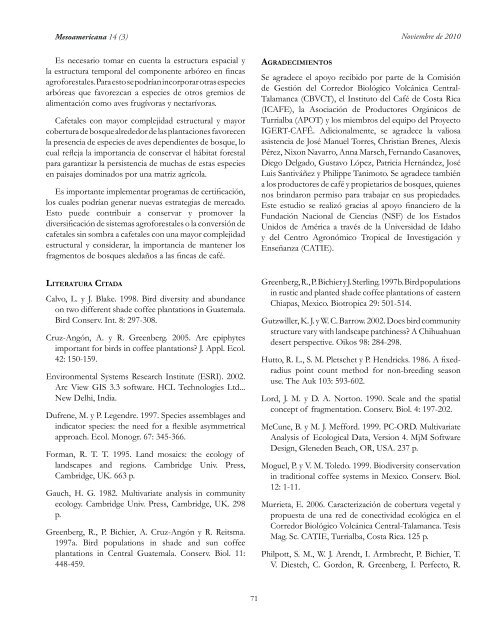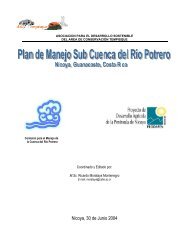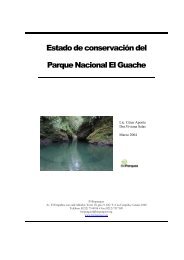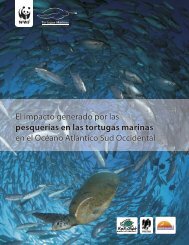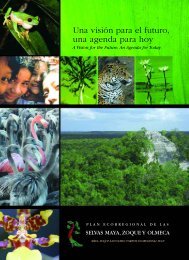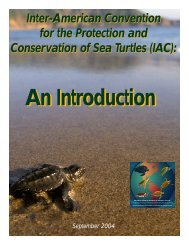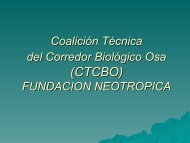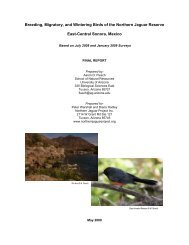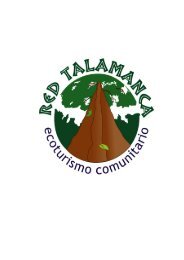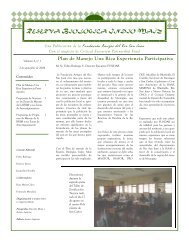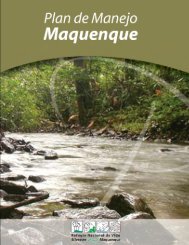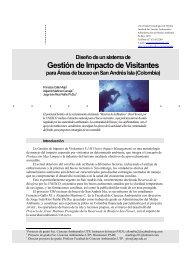Volumen 14(3) Noviembre de 2010 - Eco-Index
Volumen 14(3) Noviembre de 2010 - Eco-Index
Volumen 14(3) Noviembre de 2010 - Eco-Index
Create successful ePaper yourself
Turn your PDF publications into a flip-book with our unique Google optimized e-Paper software.
Mesoamericana <strong>14</strong> (3) <strong>Noviembre</strong> <strong>de</strong> <strong>2010</strong>Es necesario tomar en cuenta la estructura espacial yla estructura temporal <strong>de</strong>l componente arbóreo en fincasagroforestales. Para esto se podrían incorporar otras especiesarbóreas que favorezcan a especies <strong>de</strong> otros gremios <strong>de</strong>alimentación como aves frugívoras y nectarívoras.Cafetales con mayor complejidad estructural y mayorcobertura <strong>de</strong> bosque alre<strong>de</strong>dor <strong>de</strong> las plantaciones favorecenla presencia <strong>de</strong> especies <strong>de</strong> aves <strong>de</strong>pendientes <strong>de</strong> bosque, locual refleja la importancia <strong>de</strong> conservar el hábitat forestalpara garantizar la persistencia <strong>de</strong> muchas <strong>de</strong> estas especiesen paisajes dominados por una matriz agrícola.Es importante implementar programas <strong>de</strong> certificación,los cuales podrían generar nuevas estrategias <strong>de</strong> mercado.Esto pue<strong>de</strong> contribuir a conservar y promover ladiversificación <strong>de</strong> sistemas agroforestales o la conversión <strong>de</strong>cafetales sin sombra a cafetales con una mayor complejida<strong>de</strong>structural y consi<strong>de</strong>rar, la importancia <strong>de</strong> mantener losfragmentos <strong>de</strong> bosques aledaños a las fincas <strong>de</strong> café.Ag r a d e c i m i e n t o sSe agra<strong>de</strong>ce el apoyo recibido por parte <strong>de</strong> la Comisión<strong>de</strong> Gestión <strong>de</strong>l Corredor Biológico Volcánica Central-Talamanca (CBVCT), el Instituto <strong>de</strong>l Café <strong>de</strong> Costa Rica(ICAFE), la Asociación <strong>de</strong> Productores Orgánicos <strong>de</strong>Turrialba (APOT) y los miembros <strong>de</strong>l equipo <strong>de</strong>l ProyectoIGERT-CAFÉ. Adicionalmente, se agra<strong>de</strong>ce la valiosaasistencia <strong>de</strong> José Manuel Torres, Christian Brenes, AlexisPérez, Nixon Navarro, Anna Marsch, Fernando Casanoves,Diego Delgado, Gustavo López, Patricia Hernán<strong>de</strong>z, JoséLuis Santiváñez y Philippe Tanimoto. Se agra<strong>de</strong>ce tambiéna los productores <strong>de</strong> café y propietarios <strong>de</strong> bosques, quienesnos brindaron permiso para trabajar en sus propieda<strong>de</strong>s.Este estudio se realizó gracias al apoyo financiero <strong>de</strong> laFundación Nacional <strong>de</strong> Ciencias (NSF) <strong>de</strong> los EstadosUnidos <strong>de</strong> América a través <strong>de</strong> la Universidad <strong>de</strong> Idahoy <strong>de</strong>l Centro Agronómico Tropical <strong>de</strong> Investigación yEnseñanza (CATIE).Li t e r a t u r a Ci ta d aCalvo, L. y J. Blake. 1998. Bird diversity and abundanceon two different sha<strong>de</strong> coffee plantations in Guatemala.Bird Conserv. Int. 8: 297-308.Cruz-Angón, A. y R. Greenberg. 2005. Are epiphytesimportant for birds in coffee plantations? J. Appl. <strong>Eco</strong>l.42: 150-159.Environmental Systems Research Institute (ESRI). 2002.Arc View GIS 3.3 software. HCL Technologies Ltd...New Delhi, India.Dufrene, M. y P. Legendre. 1997. Species assemblages andindicator species: the need for a flexible asymmetricalapproach. <strong>Eco</strong>l. Monogr. 67: 345-366.Forman, R. T. T. 1995. Land mosaics: the ecology oflandscapes and regions. Cambridge Univ. Press,Cambridge, UK. 663 p.Gauch, H. G. 1982. Multivariate analysis in communityecology. Cambridge Univ. Press, Cambridge, UK. 298p.Greenberg, R., P. Bichier, A. Cruz-Angón y R. Reitsma.1997a. Bird populations in sha<strong>de</strong> and sun coffeeplantations in Central Guatemala. Conserv. Biol. 11:448-459.Greenberg, R., P. Bichier y J. Sterling. 1997b. Bird populationsin rustic and planted sha<strong>de</strong> coffee plantations of easternChiapas, Mexico. Biotropica 29: 501-5<strong>14</strong>.Gutzwiller, K. J. y W. C. Barrow. 2002. Does bird communitystructure vary with landscape patchiness? A Chihuahuan<strong>de</strong>sert perspective. Oikos 98: 284-298.Hutto, R. L., S. M. Pletschet y P. Hendricks. 1986. A fixedradiuspoint count method for non-breeding seasonuse. The Auk 103: 593-602.Lord, J. M. y D. A. Norton. 1990. Scale and the spatialconcept of fragmentation. Conserv. Biol. 4: 197-202.McCune, B. y M. J. Mefford. 1999. PC-ORD. MultivariateAnalysis of <strong>Eco</strong>logical Data, Version 4. MjM SoftwareDesign, Glene<strong>de</strong>n Beach, OR, USA. 237 p.Moguel, P. y V. M. Toledo. 1999. Biodiversity conservationin traditional coffee systems in Mexico. Conserv. Biol.12: 1-11.Murrieta, E. 2006. Caracterización <strong>de</strong> cobertura vegetal ypropuesta <strong>de</strong> una red <strong>de</strong> conectividad ecológica en elCorredor Biológico Volcánica Central-Talamanca. TesisMag. Sc. CATIE, Turrialba, Costa Rica. 125 p.Philpott, S. M., W. J. Arendt, I. Armbrecht, P. Bichier, T.V. Diestch, C. Gordon, R. Greenberg, I. Perfecto, R.71


